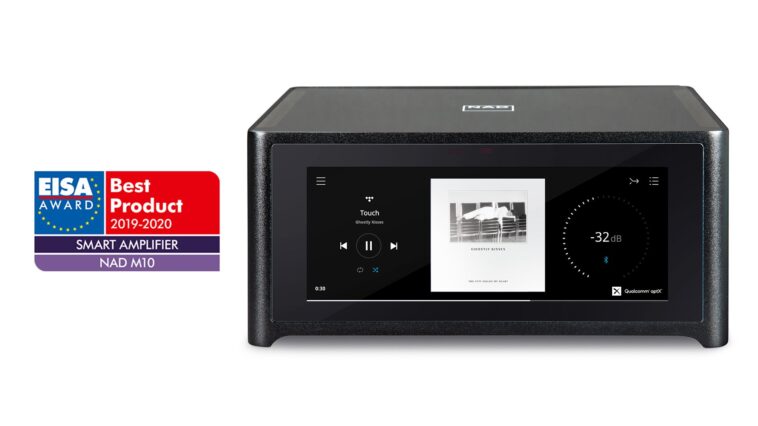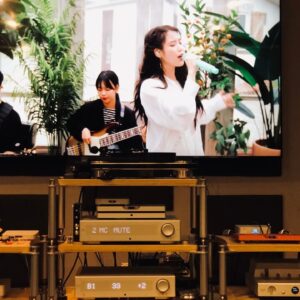나드 일렉트로닉스가 M10의 후속기 M10 V2를 출시했다. BluOS 플랫폼에서 작동하는 강력한 스트리밍 앰프로서 M10은 많은 인기를 누려왔다. 하지만 다양한 시장과 사용자의 요구를 받아들여 출력 향상 및 돌비 디지털 서라운드 디코딩 기능 추가 등을 통해 V2 버전으로 거듭났다.
우선 M10 V2는 기존 오리지널 버전 M10의 기능을 대부분 공유한다. BluOS를 통해 다양한 온라인 스트리밍 서비스 및 로커 음원 재생이 가능하다. 에어플레이 2 및 블루투스 aptX HD에 대응하며 유선으로는 광, 동축 및 HDMI eARC 등의 디지털 입력이 가능하다. USB의 경우 A타입 입력단이 있어 USB 메모리 재생도 지원한다.

특히 DF-ID의 아름다운 디자인 그리고 7인치 사이즈의 시원한 IPS 컬러 터치스크린을 통해 더 업그레이드된 시간적 만족도를 제공하고 있는 모습. 어쿠스틱 룸 보정 소프트웨어 Dirac Live를 내장하고 있는 청취 룸의 음향 특성을 보정 후 더욱 향상된 음질을 즐길 수도 있다. M10 V2는 하이펙스 nCore를 사용해 100와트 출력을 내주는 것에 더해 ‘게인 알고리즘’ 기술을 통해 낮은 능률의 스피커들에 대한 대응력을 높였다.
내장 DAC는 ESS Sabre 칩셋을 사용해 타이달, 코부즈, 아마존뮤직 등 외부 입력에 대응하며 고해상도 음원 및 MQA에 등에 대해서도 완벽 대응하고 있다. 흥미로운 건 2채널이 아닌 멀티 채널 포맷인 돌비 디지털 서라운드 포맷의 디코딩이 가능해졌다는 사실. 단, BluOS를 지원하는 무선 서라운드 스피커가 필요하다. 이를 통해 4.0, 4.1, 4.2 같은 홈 시이터 시스템을 구축할 수 있다. 최근 넷플릭스 등 OTT 시청 인구가 급증한 것을 감안한 업그레이드로 보인다. 가격은 2,199파운드/2,999유로며 8월 중 출시 예정이다.
FEATURES & DETAILS
M10 V2 BluOS Streaming Amplifier
Wireless 4.0, 4.1 and 4.2-channel surround sound options
Hybrid Digital nCore Amplifier with updated gain algorithms
Continuous Power: 100W into 8/4 Ohms
Dynamic Power: 160W into 8 Ohms 300W into 4 Ohms
32-bit/384kHz ESS Sabre DAC
Dirac Live Room Correction
IPS Color LCD display
Infrared remote control handset included
Amazon Alexa & Google Assistant voice control skills
AirPlay 2 integration, with support for Siri Voice Assistant
Roon Ready
Spotify Connect and Tidal Connect
Two-way Qualcomm aptX HD Bluetooth
NFC Bluetooth pairing for compatible smart devices
BluOS multi-room compatible
Gigabit Ethernet; Wi-Fi 802.11ac (WiFi 5)
HDMI eARC,USB Type A inputs
Stereo line analogue and coaxial/optical digital inputs
Preamp output, two independent subwoofer outputs with updated gain algorithms
IR Input, 12V Trigger Out
Apps for iOS, Android, macOS, Windows, Crestron, Control4, RTI, URC, Elan, Lutron, iPort
Wide variety of premium music services supported in BluOS app, including Amazon, Spotify,
Tidal, TuneIn, Napster, Deezer, Qobuz and many others
Support for all major lossless and lossy formats, including WAV, FLAC, AIFF, ALAC, AAC, MP3,
Ogg Vorbis, and others
MQA decoding and rendering




